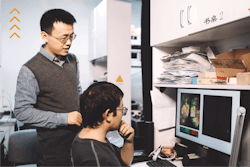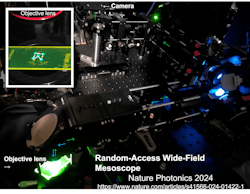Random-access Wi-Fi mesoscope enables flexible in vivo biodynamics imaging
Inspired by human’s attention mechanism within our visual processing system, which can selectively attend to parts of a scene, a team of researchers at Tsinghua University (Beijing, China) recently developed a flexible, compact, low-cost random-access wide-field (RA Wi-Fi) mesoscope to image samples of various shapes, sizes, and orientations in vivo (inside).
It’s designed to eliminate acquiring useless data outside of targeted regions of interest (ROIs) and improve temporal resolution in practical imaging (see video).
“Instead of taking in the whole view in parallel, we created RA-Wi-Fi mesoscopy to record biodynamics over targeted ROIs at high spatiotemporal resolutions in vivo,” says Lingjie Kong, an associate professor at Tsinghua University’s Precision Instrument Department.
Setup/how does RA-Wi-Fi mesoscopy work?
The team’s setup involves a commercial infinity-corrected objective of a high space-bandwidth product (SBP), with two custom-designed lenses for larger aperture and minimal aberration, and several commercial lenses. Their design goal was to make it compact and keep costs low, while supporting multiple imaging modes: dual-color fluorescence, bright-field imaging, and dark-field imaging.
“To ensure high spatial resolutions and high temporal resolutions in mesoscale imaging, we divide the whole field of view (FOV) into multiple sub-FOVs and adopt a random-access strategy,” explains Kong. “We also extend the FOV of a commercial objective of a high SBP to beyond its nominal value by enlarging the object distance, which subsequently leads to a lower field angle, and correct optical aberrations via adaptive optics combined with an electronically tunable lens for compensating Petzval field curvature (an optical aberration within the lens that causes the image plane to curve).”
To inhibit the inherent background in single-photon fluorescence imaging, the team performs structured illumination and computation reconstruction for optical sectioning. A RA-Wi-Fi mesoscope essentially acquires optical-sectioning sub-FOV images within a wide field by rapid galvo-mirror scanning with field-wise aberration corrections and focal plane adjustments to each sub-FOV.
In fluorescence imaging mode, the mesoscope works by sending light from light-emitting diodes (LEDs) through a series of relay lenses, a digital micromirror device (for structured-illumination-based optical sectioning), and a two-axis galvo (for random access) before the sample is excited.
“Emission signals are collected by the objective and go back through the system to a camera, during which optical aberrations are corrected by a deformable mirror,” Kong explains.
RA-Wi-Fi mesoscope offers flexibility
What’s the coolest aspect of a RA-Wi-Fi mesoscope? “Its ability to flexibly allocate imaging resources to irregular ROIs, which improves temporal resolutions and avoids acquisition of redundant data,” says Kong. “This, in turn, reduces the system cost by adopting a commercial objective and enlarging its FOV via a lower-field-angle method.”
One of the highlights of this work for the team was when they demonstrated their RA-Wi-Fi mesoscope could provide dynamic imaging of a curved, elongated mouse spinal cord in vivo. “It was exciting,” says Kong. “And wide adoption of RA-Wi-Fi mesoscopes can benefit various studies of biodynamics in vivo, including neuroscience and immunology.”
A fix for tradeoffs between imaging speed vs. imaging large areas
Although the random-access method ensures high temporal resolutions in large-scale imaging, there are tradeoffs between imaging speed and imaging regions. “For targeted regions of a large area, the method’s imaging speed may not be sufficient for certain applications,” Kong says. “So we explored the bottlenecks of imaging speed and discovered its current speed is limited by the total time required for light exposure and data readout. Light exposure can be minimized by enhancing fluorescence excitation, emission, and collection, or by using a denoise algorithm.”
It begged the question: Can the adverse effects of a long readout time be reduced? “An a-ha moment hit when we recalled the spatiotemporal sparsity of most biological dynamics—based on our earlier work—and proposed our ‘one-shot, multiple FOVs’ method,” says Kong.
In this method, the camera integrates continuous exposures of multiple sub-FOVs, but the data transfers only once. Signals for each sub-FOV can be computationally de-mixed, based on prior knowledge of spatial distributions of neurons or blood vessels.
In pursuit of faster image acquisition
Kong and colleagues demonstrated applications of their one-shot two sub-FOVs method for both functional imaging of neural activity and structural imaging of vascular dynamics in vivo—and achieved ~25% faster acquisition.
“The concept of RA-Wi-Fi imaging can be transferred in volumetric imaging of biodynamics in vivo, in which the integration of RA-Wi-Fi excitation and light-field detection looks promising,” Kong says. “We’re currently developing a system that shows potential for dynamic imaging of freely moving zebrafish larva—without disturbing or shaking the water arena.”
FURTHER READING
R. Shi et al., Nat. Photon. (2024); https://doi.org/10.1038/s41566-024-01422-1.
About the Author
Sally Cole Johnson
Editor in Chief
Sally Cole Johnson, Laser Focus World’s editor in chief, is a science and technology journalist who specializes in physics and semiconductors.


